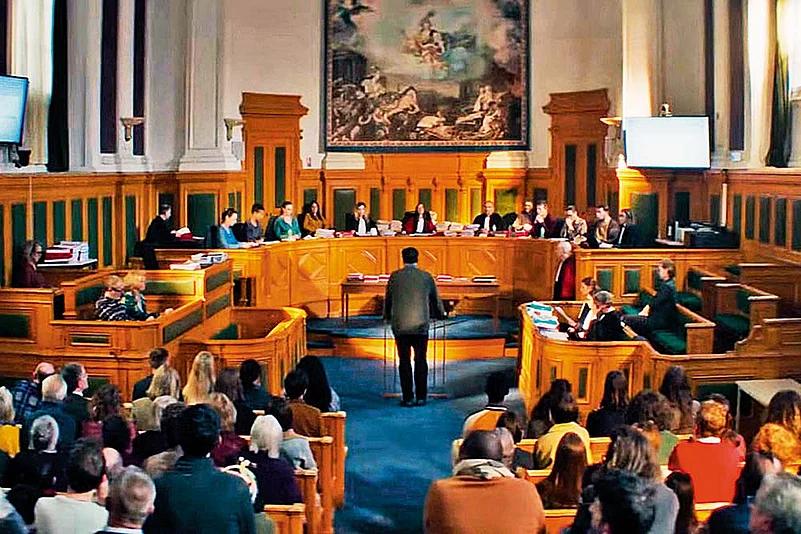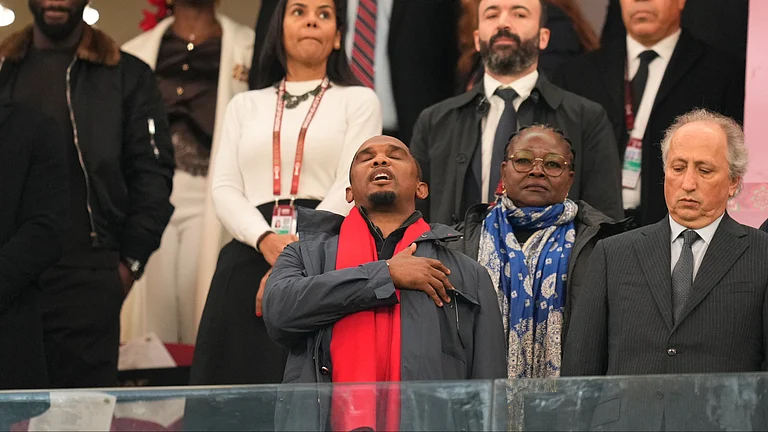“Madam Coly, do you know why you killed your daughter?” When asked this question, Lawrence Coly responds with a demure yet unsettling reply, “I do not know. I hope this trial will give me the answer.” This chilling exchange sets the tone for Alice Diop’s Saint-Omer (Silver Lion winner, Venice, 2022).
Saint-Omer is based on a real-life incident in the town of Saint-Omer wherein Fabienne Kabou, a Senegalese immigrant woman, abandoned her 15-month-old child on Berck-sur-Mer beach, allowing the baby to drown, leading to a legal trial. In Saint-Omer, Lawrence Coly, a fictional representation of Fabienne Kabou, confronts a similar accusation of forsaking her breastfed infant on the seaside to die. Diop captures the chilling testimony in her film, witnessed in the actual Saint-Omer courtroom in 2016.
Coly’s equivocal and dissatisfying responses to the inquiries from the white female judge leave both the courtroom audience and film viewers grappling with the confounding question: Why would a mother engage in such an ‘unmotherly’ act?
This question is equally relevant in the South-Asian context. The 2019 report from the National Crime Report Bureau (NCRB) reveals that Maharashtra alone recorded 1,451 cases of abandoned newborns between 2011 and 2017. Rajasthan followed closely, trailed by Gujarat, Karnataka and Madhya Pradesh. Indian mythology too features several instances: in the Mahabharata, Kunti, the mother of the Pandavas, had to abandon her first child, Karna, since he was born out of wedlock.
In Saint-Omer, Coly, mirroring Fabienne, attributes the commission of the heinous crime to the curse of the evil eye afflicting her family. The white judicial system (French in this case), is taken aback by Coly’s unabashed invocation of resorting to witchcraft as an explanation.
Diop, well-known for her documentaries, seeks answers by posing a clutch of relevant questions in her debut feature film. Much like how Diop observed the original trial, in the film, Rama, a novelist and lecturer, is present in the courtroom to witness Coly’s trial. While Coly recounts her story with blatant straightforwardness, her reactions convey a blend of trauma, terror and ambivalence. Rama’s presence in the courtroom functions as our lens into the unfolding events. There are instances when Rama’s involved expression becomes the viewer’s most immediate connection to the narrative.

Despite the judge’s efforts to uncover the truth behind Coly’s case, there is a lingering sense of Coly being perceived as the “other”—something beyond the “normal” realm of French life, saturating the atmosphere in the courtroom.
Coly’s white partner, Luc Dumontet, over 30 years her senior, is married and has an adult daughter. When the judge asks him about his participation in Coly’s pregnancy—specifically, whether he attended doctor’s appointments—his response is an unequivocal “No.” He elaborates, stating, “I don’t know how to do that. When I had my first daughter, men didn’t do those things.”
The dynamics at play here reveal the subconscious undercurrent of white patriarchal supremacy in Dumontet’s mind, hindering him from providing the required care for Coly, a black immigrant.
Despite the judge’s efforts to uncover the truth behind Coly’s case, there is a sense of Coly being perceived as something beyond the “normal” realm of french life.
When questioned by the judge about her experiences during pregnancy, Coly conveys the profound sense of despair she endured during that period. She confesses to experiencing a pervasive fear of solitude in her flat, describing an increasingly hostile atmosphere. Throughout those challenging months, she found herself immobilised, unable to get out of bed in the morning, plagued by headaches and blurred vision that seemed to conjure strange noises. When she shared her distress with Luc, he paid little attention. When asked if she sought medical advice, Coly discloses that she sought help from a psychoanalyst and an osteopath, but to no avail. In her desperate attempt to convey her turmoil to the jurors, Coly asserts that “sorcery was the only logical conclusion’’.
The court proceedings bring to light Coly’s tumultuous childhood, her parents’ divorce, and her mother’s relentless pressure to succeed in her career. All these make her teenage years a struggle. At the age of 18, seeking relief from parental expectations, Coly flees to France. Despite excelling academically, she faces demeaning remarks from a female professor who questions her choice to study Wittgenstein as a black immigrant. When the professor is asked to give her testimony in court, she says, “Isn’t it rather odd, an African woman interested in an Austrian philosopher! Why not choose someone from her own culture?”
This encounter highlights the pervasive white intellectual arrogance that undermines the capabilities of people of colour. To go back to Wittgenstein, his well-known quote asserts, “The limits of the world are also the limits of logic.” Does the West acknowledge that its understanding of logic is essentially an abstract concept confined within the boundaries of its own world? This Western perspective appears indifferent and in denial concerning the fundamental aspects of Lawrence Coly or Fabienne Kabou’s existence!
As the case unfolds on screen, the audience is compelled to confront not only the personal tragedy of a mother’s unthinkable act but also broader questions about European rationality in the face of othering. Diop adeptly navigates the intricacies, offering a nuanced exploration of societal attitudes toward those perceived as ‘different’.
In Justine Triet’s Anatomy of a Fall, despite the case going in Sandra’s favour, her logical explanations are dismissed as weak feminine excuses by the male judiciary.
This social marginalisation that often leads to complete ostracisation of the people who society fails to understand and therefore tags as the “other” pervades another courtroom on celluloid as well. Sandra, an accomplished German author, is charged as the prime suspect in her husband Samuel’s murder in the feted legal drama Anatomy of a Fall (Palm d’Or winner, 2023; directed by Justine Triet). Sandra lives in seclusion in the French Alps with Samuel and their visually impaired son Daniel. When Samuel is found dead below their chalet, the investigation probes their complex relationship, scrutinising Sandra’s successful career and her bisexuality. Samuel, a struggling writer, faced rejection from publishers while Sandra’s career thrived. The possibilities of suicide or foul play by Sandra arise, fuelled by an audio recording capturing a heated argument between them.
During her trial, Sandra’s defense lawyer, Vincent, confronts her about the recording, emphasising the importance of public perception. The public’s view of Sandra, a vibrant and successful woman, is likely unfavourable, given Samuel’s struggles and mental health issues. Vincent delivers a striking response to Sandra’s plea, stating, “You need to see yourself the way others will perceive you. The trial is not about the truth.”
While Samuel’s therapist indirectly implicates Sandra in Samuel’s mental health decline during court proceedings, Sandra questions the therapist’s perspective, suggesting that similar criticisms could be made about Samuel if she were in therapy.
But what is the truth? Sandra’s reaction to the therapist implies that her truths will invariably differ if the court cares to change the lens. The same logic would have been applied to Coly’s case had the white judicial system attempted to understand the psychology of alienation and precarity in a black immigrant woman.
There is a striking contrast between the two perspectives in the films. Sandra remains rational, constructing her defense with logic, and emphasising the complexities of relationships. Meanwhile, Coly distances herself from rationality, attributing the crime she committed to the “evil eye” and relying on her own logic. Maternal filicide, as depicted in Coly’s case, is profoundly disturbing for a sane and logical world. She informs the judge that Luc arrived a few days after her daughter’s birth. Luc’s initial reaction, upon seeing her with the newborn, was skepticism. He questioned the child’s paternity, prompting a deeply wounded Coly to assert, “Don’t worry. She’s mine.”
Biological anthropologist Daniela F Sieff’s essay titled ‘Death Mother as Nature’s Shadow’ addresses the lingering question that keeps disturbing us: Why did Coly murder her child?
“A woman who grew up with unloving and hostile parents might internalise that way of parenting and then repeat it with her infants…Infanticidal wishes can also be triggered when couples split up, and the one who feels the loss unbearable follows the path of Medea, the Greek mythological character who killed her children to dole out the ultimate punishment on her deserter.”
Coly claims that she had a violent clash with her partner Luc before she committed the crime. In her essay, Sieff explains that mothering does not occur in a vacuum, and the way a woman responds to her children is influenced not only by what is happening in her psyche and her body, but also by the external physical, relational and economic environment.
A woman like Coly might see her vulnerability reflected in her baby. Her case scrutinises aspects of motherhood, post-natal depression, Western rationality versus African surrender to fate and racial othering. These themes leave an enduring impression, compelling viewers to confront unsettling truths about the extreme helplessness that can trigger the dark recesses of the human psyche.
The ‘civilised and rational’ white West struggles to comprehend Coly, yet, it readily implicates Sandra for her ambition and modernity. In the concluding scenes of Saint-Omer, the final judgement remains unseen. Coly’s lawyer concludes the last appeal with a scientific explanation, delving into Coly’s hallucinations and mental state that led to the filicide. The lawyer advocates for medical care for Coly, an option unattainable in prolonged imprisonment. In reality, Fabienne Kabou received a 15-year prison sentence. In Anatomy of a Fall, despite the case going in Sandra’s favour, her logical explanations are dismissed as weak feminine excuses by the male judiciary.
At the end of both films, the narratives intersect and deviate. While Sandra, embodying the white perspective, attains justice or closure through her logical explanations, Coly is left in a state of anticipation for justice. Yet, it’s acknowledged by both her and the viewers that achieving justice for a black individual in a white court is often an interminable process or an elusive ideal, akin to the search for water in the Sahara.
(Views expressed are personal)
Debarati Gupta is a Filmmaker, Columnist and Guest Lecturer at the University of Calcutta
(This appeared in the print as 'Shades Of Justice')


























